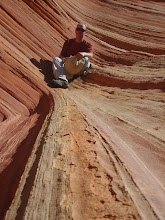Science Daily http://www.sciencedaily.com/ has a linked article on the Japanese earthquake and the resulting nuclear disaster. http://www.newsdaily.com/stories/tre72g65z-us-japan-quake-meltdown-specialreport/
Except for one sentence, I agree with the article. The article says "As the first pictures of the destruction around the northern town of Sendai were beamed across Japan and around the world in the hours after the quake, authorities initially said they had safely shut down the four nuclear plants closest to the earthquake and tsunami zone.
It wasn't true. With no power to the plant's cooling system, the water that circulates around the fuel rods inside the six reactors at Fukushima had already begun to boil off. Within a few hours authorities declared a "nuclear emergency situation" at the plant. While no radiation release had been detected, they said, residents around the plant should evacuate."
It was 93 percent true. The control and safety rods entered the core, and fission went from 93 percent of design power to 0.01 percent power. Fission product decay remained at 7 percent power. That is how nuclear engineers define "safely shut down", so the statement was true. But, that 7 percent power continued to heat the fuel rods, and that heat needed to be carried away. It was carried away - safely - until fifteen minutes later when a 30 foot tsunami hit and wiped out the fuel supply for the emergency diesel generators.
Then, a natural disaster became a catastrophe. And the nuclear event became a disaster.
But, so far, the nuclear disaster has not become a catastrophe.
The current situation is:
The reactors at Fukushima Daini are recovering, with three of the four damaged and in a Level 3 event state. Those three reactors may, or may not, restart after damage is repaired. The fourth has a better chance
Three of the six reactors at Fukushima Daiichi are in serious trouble, with probably molten fuel in the cores; they are in Level 5 event states; the other three reactors were in an outage, and fuel was already removed from one when the quake struck. Fuel in then other three is safe. (see http://www.jaif.or.jp/english/news_images/pdf/ENGNEWS01_1300624909P.pdf)
I would be astounded if reactors # 1 , 2, or 3 ever operate again. Meanwhile, the fuel storage pool for #4 was dried out - either by sloshing during the quake or by a leak. The stored fuel overheated, the cladding reacted with remaining water, and there was a hydrogen explosion outside the containment which destroyed the reactor building. Water was restored by fire cannon and helicopter drop.
All six reactor cores are inside containments, and all six containments are functional, although unit #2 has suspected damage.
As long as the containments remain reasonably intact, Japanese citizens have no cause for fear - though they may be very fearful. Many times, smaller earthquakes than this cause deaths from heart attacks. The nuclear risks may also cause heart attacks. Preventing those fear-induced medical events is a major purpose of these posts.
For United Sates residents, there is no reason to fear. As noted below, the radioactivity within the fuel cores has decayed to less than 0.14 percent of full power, so even if something could somehow vaporize the cores and the containments, the result would be less than one in 50 of what Chernobyl was. And the evacuation to 12 miles makes it less than one in 1,000 of Chernobyl. That means, less than four cancers - worldwide.
As to the radioactivity now reaching U.S. shores, the level is below what we get when we eat bananas. That's right, bananas. Eating one banana shows up when nuclear professionals get our annual "whole body count". Every time they do this, I have the same count - one body :-). The "whole body count" (http://en.wikipedia.org/wiki/Whole_body_counting ) measures the radioactive material in the human body. If too much potassium-40 shows up, the technician asks how many bananas we eat. Bananas have lots of potassium, some of which is radioactive potassium-40. The benefits of potassium far outweigh any negative effects of the radiation. So, eat your bananas, and take courage - this "radioactive cloud" is less than one billionth of what we should worry about.
Sunday, March 20, 2011
Subscribe to:
Post Comments (Atom)

No comments:
Post a Comment